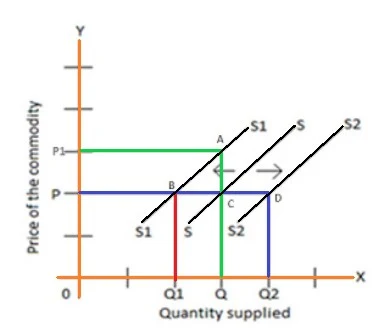Movement and shift in the supply curve:
Movement in the supply curve:
A movement in a supply curve is a change in supply as a result of a change in price. Movement along a supply curve represents the variation in quantity supplied of the commodity with a change in its price and other factors remaining unchanged.The movement in the supply curve can be of two types – extension and contraction. Extension in a supply curve is caused when there is an increase in the price or quantity supplied of the commodity while the contraction is caused due to a decrease in the price or quantity supplied of the commodity.
The shift in supply curve:
A shift in a supply curve is a change in supply for a reason other than a change in price. The amount of commodity that the producers or suppliers are willing to offer at the marketplace can change even in cases when factors other than the price of the commodity change. Such non-price factors can be the cost of factors of production, tax rate, state of technology, natural factors, etc.when the quantity of the commodity supplied changes due to change in non-price factors; the supply curve does not extend or contract but shifts entirely. This is known as a shift in the supply curve.
They can be presented and explained by the help of the following diagram:
In the above graph, the movement from point A to B is movement of supply curve whereas the movement of supply curve from S to S1 ( C to A or C to B) and S to S2 is the shift in supply curves.
Factors Causing Shift in Supply curve:
- Price of factors of production
- Price of other commodities
- Goals of firms
- State of technology
- Effects of taxation
- Government regulation


0 Comments
If this article has helped you, please leave a comment.